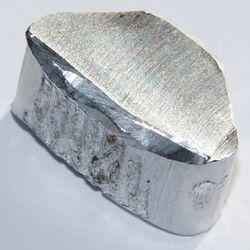Template:Infobox aluminium
From HandWiki
 | ||||||||||||||||||||
| Aluminium | ||||||||||||||||||||
|---|---|---|---|---|---|---|---|---|---|---|---|---|---|---|---|---|---|---|---|---|
| Pronunciation |
| |||||||||||||||||||
| Alternative name | aluminum (U.S., Canada) | |||||||||||||||||||
| Appearance | silvery gray metallic | |||||||||||||||||||
| Standard atomic weight Ar, std(Al) | 26.9815384(3)[1] | |||||||||||||||||||
| Aluminium in the periodic table | ||||||||||||||||||||
| ||||||||||||||||||||
| Atomic number (Z) | 13 | |||||||||||||||||||
| Group | group 13 (boron group) | |||||||||||||||||||
| Period | period 3 | |||||||||||||||||||
| Block | p-block | |||||||||||||||||||
| Element category | p-block, [2][lower-alpha 1] sometimes considered a metalloid | |||||||||||||||||||
| Electron configuration | [Ne] 3s2 3p1 | |||||||||||||||||||
| Electrons per shell | 2, 8, 3 | |||||||||||||||||||
| Physical properties | ||||||||||||||||||||
| Phase at STP | solid | |||||||||||||||||||
| Melting point | 933.47 K (660.32 °C, 1220.58 °F) | |||||||||||||||||||
| Boiling point | 2743 K (2470 °C, 4478 °F) | |||||||||||||||||||
| Density (near r.t.) | 2.70 g/cm3 | |||||||||||||||||||
| when liquid (at m.p.) | 2.375 g/cm3 | |||||||||||||||||||
| Heat of fusion | 10.71 kJ/mol | |||||||||||||||||||
| Heat of vaporization | 284 kJ/mol | |||||||||||||||||||
| Molar heat capacity | 24.20 J/(mol·K) | |||||||||||||||||||
Vapor pressure
| ||||||||||||||||||||
| Atomic properties | ||||||||||||||||||||
| Oxidation states | −2, −1, +1,[4] +2,[5] +3 (an amphoteric oxide) | |||||||||||||||||||
| Electronegativity | Pauling scale: 1.61 | |||||||||||||||||||
| Ionization energies |
| |||||||||||||||||||
| Atomic radius | empirical: 143 pm | |||||||||||||||||||
| Covalent radius | 121±4 pm | |||||||||||||||||||
| Van der Waals radius | 184 pm | |||||||||||||||||||
| Spectral lines of aluminium | ||||||||||||||||||||
| Other properties | ||||||||||||||||||||
| Natural occurrence | primordial | |||||||||||||||||||
| Crystal structure | face-centered cubic (fcc) | |||||||||||||||||||
| Speed of sound thin rod | (rolled) 5000 m/s (at r.t.) | |||||||||||||||||||
| Thermal expansion | 23.1 µm/(m·K) (at 25 °C) | |||||||||||||||||||
| Thermal conductivity | 237 W/(m·K) | |||||||||||||||||||
| Electrical resistivity | 26.5 nΩ·m (at 20 °C) | |||||||||||||||||||
| Magnetic ordering | paramagnetic[6] | |||||||||||||||||||
| Magnetic susceptibility | +16.5·10−6 cm3/mol | |||||||||||||||||||
| Young's modulus | 70 GPa | |||||||||||||||||||
| Shear modulus | 26 GPa | |||||||||||||||||||
| Bulk modulus | 76 GPa | |||||||||||||||||||
| Poisson ratio | 0.35 | |||||||||||||||||||
| Mohs hardness | 2.75 | |||||||||||||||||||
| Vickers hardness | 160–350 MPa | |||||||||||||||||||
| Brinell hardness | 160–550 MPa | |||||||||||||||||||
| CAS Number | 7429-90-5 | |||||||||||||||||||
| History | ||||||||||||||||||||
| Naming | after alumina (aluminium oxide), itself named after mineral alum | |||||||||||||||||||
| Prediction | Antoine Lavoisier (1782) | |||||||||||||||||||
| Discovery | Hans Christian Ørsted (1824) | |||||||||||||||||||
| Named by | Humphry Davy (1808, 1812) | |||||||||||||||||||
| Main isotopes of aluminium | ||||||||||||||||||||
| ||||||||||||||||||||
Al data m.p. cat
| |||||
|---|---|---|---|---|---|
| in | calc from C | diff | report | ref | |
| C | 660.32 | — | — | ||
| K | 933.47 | 933.47 | 0 | ||
| F | 1220.58 | 1220.58 | 0 | ||
| max precision | 2 | ||||
| WD |
|
||||
| input | C: 660.32, K: 933.47, F: 1220.58 | ||||
| comment | |||||
Al data b.p. cat
| |||||
|---|---|---|---|---|---|
| in | calc from C | diff | report | ref | |
| C | 2470 | — | — | ||
| K | 2743 | 2740 | 3 | delta | |
| F | 4478 | 4480 | -2 | delta | |
| max precision | 0 | ||||
| WD |
|
||||
| input | C: 2470, K: 2743, F: 4478 | ||||
| comment | |||||
| Mg ← |
→ Si | |
| ||
|
| ||
| [] Data sets read by {{Infobox element}} | |
|---|---|
| Name and identifiers | |
| Top image (caption, alt) | |
| Pronunciation | |
| Category (enwiki) | |
| Standard atomic weight | |
| most stable isotope | |
| Natural occurrence | |
| Phase at STP | |
| Chemistry:Oxidation states | |
| Spectral lines image | |
| Physics:Electron configuration (cmt, ref) | |
| Term symbol * (cmt, ref) | |
| Wikidata * | |
| * Not used in {{Infobox element}} (2019-02-03) See also {{Infobox element/symbol-to--navbox}} | |
- ↑ As aluminium technically does not come after any transition metals in the periodic table, it is excluded by some authors from the set of post-transition metals.[3] Nevertheless its weakly metallic behaviour is similar to that of its heavier congeners in group 13 gallium, indium, and thallium, which are post-transition metals by all definitions.
References
- ↑ Meija, Juris; Coplen, Tyler B.; Berglund, Michael; Brand, Willi A.; De Bièvre, Paul; Gröning, Manfred; Holden, Norman E.; Irrgeher, Johanna et al. (2016). "Atomic weights of the elements 2013 (IUPAC Technical Report)". Pure and Applied Chemistry 88 (3): 265–91. doi:10.1515/pac-2015-0305.
- ↑ Whitten KW, Davis RE, Peck LM & Stanley GG 2014, Chemistry, 10th ed., Thomson Brooks/Cole, Belmont, California, ISBN:1-133-61066-8, p. 1045
- ↑ Cox PA 2004, Inorganic chemistry, 2nd ed., Instant notes series, Bios Scientific, London, ISBN:1-85996-289-0, p. 186
- ↑ Dohmeier, C.; Loos, D.; Schnöckel, H. (1996). "Aluminum(I) and Gallium(I) Compounds: Syntheses, Structures, and Reactions". Angewandte Chemie International Edition 35 (2): 129–149. doi:10.1002/anie.199601291.
- ↑ D. C. Tyte (1964). "Red (B2Π–A2σ) Band System of Aluminium Monoxide". Nature 202 (4930): 383. doi:10.1038/202383a0. Bibcode: 1964Natur.202..383T.
- ↑ Lide, D. R. (2000). "Magnetic susceptibility of the elements and inorganic compounds". CRC Handbook of Chemistry and Physics (81st ed.). CRC Press. ISBN 0849304814. http://www-d0.fnal.gov/hardware/cal/lvps_info/engineering/elementmagn.pdf.
One of these is a named reference. It may be cited in the containing article as
- <ref name="CIAAW2013" /> for the source Atomic weights of the elements 2013 (from subtemplates used by {{Infobox element}})

